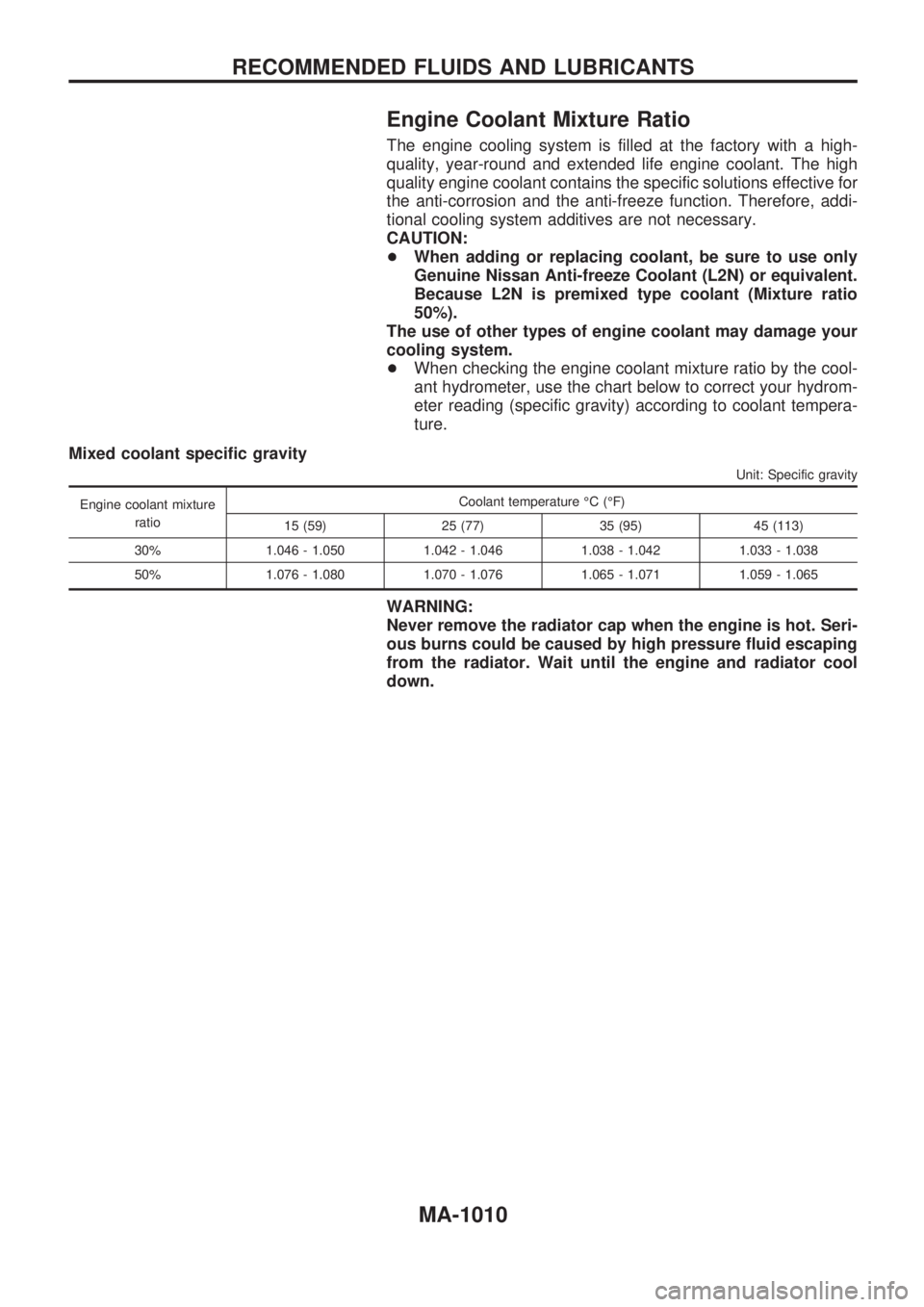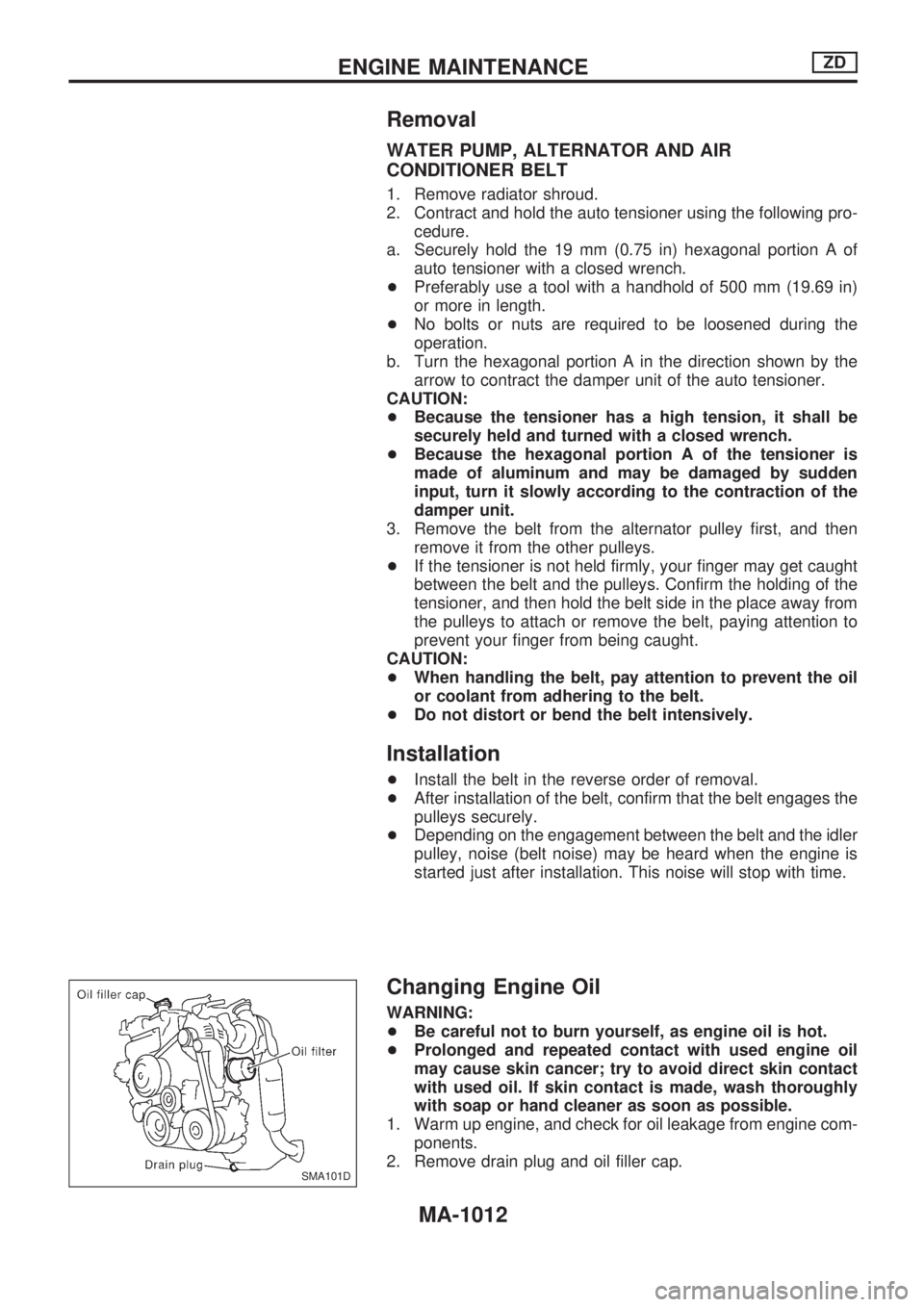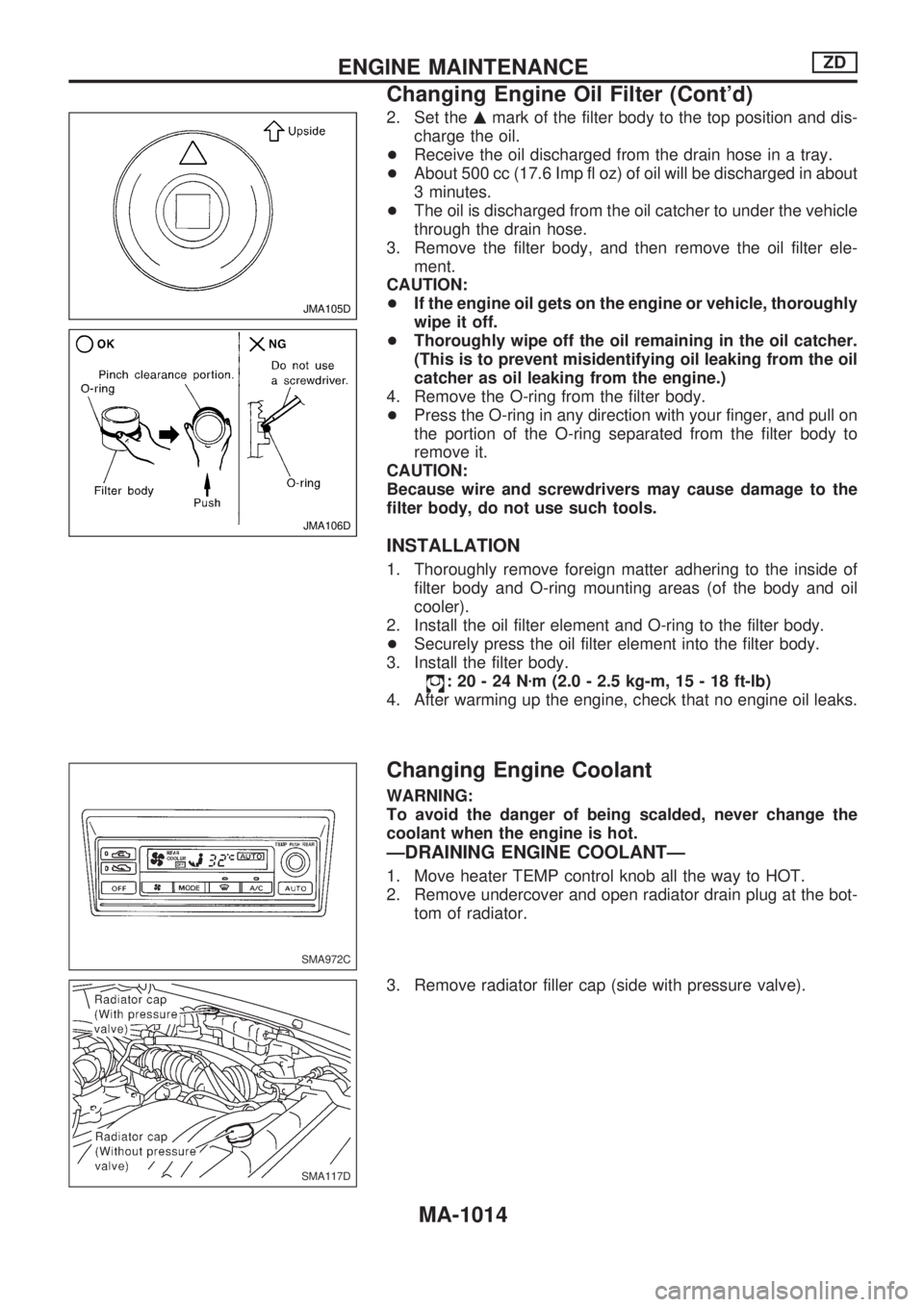Page 908 of 1033

Engine Coolant Mixture Ratio
The engine cooling system is filled at the factory with a high-
quality, year-round and extended life engine coolant. The high
quality engine coolant contains the specific solutions effective for
the anti-corrosion and the anti-freeze function. Therefore, addi-
tional cooling system additives are not necessary.
CAUTION:
+When adding or replacing coolant, be sure to use only
Genuine Nissan Anti-freeze Coolant (L2N) or equivalent.
Because L2N is premixed type coolant (Mixture ratio
50%).
The use of other types of engine coolant may damage your
cooling system.
+When checking the engine coolant mixture ratio by the cool-
ant hydrometer, use the chart below to correct your hydrom-
eter reading (specific gravity) according to coolant tempera-
ture.
Mixed coolant specific gravity
Unit: Specific gravity
Engine coolant mixture
ratioCoolant temperature ÉC (ÉF)
15 (59) 25 (77) 35 (95) 45 (113)
30% 1.046 - 1.050 1.042 - 1.046 1.038 - 1.042 1.033 - 1.038
50% 1.076 - 1.080 1.070 - 1.076 1.065 - 1.071 1.059 - 1.065
WARNING:
Never remove the radiator cap when the engine is hot. Seri-
ous burns could be caused by high pressure fluid escaping
from the radiator. Wait until the engine and radiator cool
down.
RECOMMENDED FLUIDS AND LUBRICANTS
MA-1010
Page 910 of 1033

Removal
WATER PUMP, ALTERNATOR AND AIR
CONDITIONER BELT
1. Remove radiator shroud.
2. Contract and hold the auto tensioner using the following pro-
cedure.
a. Securely hold the 19 mm (0.75 in) hexagonal portion A of
auto tensioner with a closed wrench.
+Preferably use a tool with a handhold of 500 mm (19.69 in)
or more in length.
+No bolts or nuts are required to be loosened during the
operation.
b. Turn the hexagonal portion A in the direction shown by the
arrow to contract the damper unit of the auto tensioner.
CAUTION:
+Because the tensioner has a high tension, it shall be
securely held and turned with a closed wrench.
+Because the hexagonal portion A of the tensioner is
made of aluminum and may be damaged by sudden
input, turn it slowly according to the contraction of the
damper unit.
3. Remove the belt from the alternator pulley first, and then
remove it from the other pulleys.
+If the tensioner is not held firmly, your finger may get caught
between the belt and the pulleys. Confirm the holding of the
tensioner, and then hold the belt side in the place away from
the pulleys to attach or remove the belt, paying attention to
prevent your finger from being caught.
CAUTION:
+When handling the belt, pay attention to prevent the oil
or coolant from adhering to the belt.
+Do not distort or bend the belt intensively.
Installation
+Install the belt in the reverse order of removal.
+After installation of the belt, confirm that the belt engages the
pulleys securely.
+Depending on the engagement between the belt and the idler
pulley, noise (belt noise) may be heard when the engine is
started just after installation. This noise will stop with time.
Changing Engine Oil
WARNING:
+Be careful not to burn yourself, as engine oil is hot.
+Prolonged and repeated contact with used engine oil
may cause skin cancer; try to avoid direct skin contact
with used oil. If skin contact is made, wash thoroughly
with soap or hand cleaner as soon as possible.
1. Warm up engine, and check for oil leakage from engine com-
ponents.
2. Remove drain plug and oil filler cap.
SMA101D
ENGINE MAINTENANCEZD
MA-1012
Page 912 of 1033

2. Set themmark of the filter body to the top position and dis-
charge the oil.
+Receive the oil discharged from the drain hose in a tray.
+About 500 cc (17.6 Imp fl oz) of oil will be discharged in about
3 minutes.
+The oil is discharged from the oil catcher to under the vehicle
through the drain hose.
3. Remove the filter body, and then remove the oil filter ele-
ment.
CAUTION:
+If the engine oil gets on the engine or vehicle, thoroughly
wipe it off.
+Thoroughly wipe off the oil remaining in the oil catcher.
(This is to prevent misidentifying oil leaking from the oil
catcher as oil leaking from the engine.)
4. Remove the O-ring from the filter body.
+Press the O-ring in any direction with your finger, and pull on
the portion of the O-ring separated from the filter body to
remove it.
CAUTION:
Because wire and screwdrivers may cause damage to the
filter body, do not use such tools.
INSTALLATION
1. Thoroughly remove foreign matter adhering to the inside of
filter body and O-ring mounting areas (of the body and oil
cooler).
2. Install the oil filter element and O-ring to the filter body.
+Securely press the oil filter element into the filter body.
3. Install the filter body.
:20-24Nzm (2.0 - 2.5 kg-m, 15 - 18 ft-lb)
4. After warming up the engine, check that no engine oil leaks.
Changing Engine Coolant
WARNING:
To avoid the danger of being scalded, never change the
coolant when the engine is hot.
ÐDRAINING ENGINE COOLANTÐ
1. Move heater TEMP control knob all the way to HOT.
2. Remove undercover and open radiator drain plug at the bot-
tom of radiator.
3. Remove radiator filler cap (side with pressure valve).
JMA105D
JMA106D
SMA972C
SMA117D
ENGINE MAINTENANCEZD
Changing Engine Oil Filter (Cont'd)
MA-1014
Page 913 of 1033
4. Remove water inlet and cylinder block drain plug located at
left center of cylinder block.
5. Remove reservoir tank (sides with pressure valve and with-
out pressure valve) and drain coolant.
ÐREFILLING ENGINE COOLANTÐ
6. Install reservoir tank, radiator drain plug, and cylinder block
drain plugs.
+Apply sealant to the thread of cylinder block drain plug.
Cylinder block drain plug:
:24-26Nzm (2.4 - 2.7 kg-m, 18 - 19 ft-lb)
Water inlet drain plug:
Height (H) mm (in): 5.0 - 7.8 (0.197 - 0.307)
7. Move heater TEMP control knob all the way to HOT.
8. Fill radiator with coolant up to the filler neck and install radia-
tor cap.
For coolant mixture ratio, refer to MA-1010.
9. Fill reservoir tank (with pressure valve) with coolant up to the
filler neck.
10. Fill reservoir tank with coolant up to the MAX level.
JMA107D
SMA108D
SMA182B
ENGINE MAINTENANCEZD
Changing Engine Coolant (Cont'd)
MA-1015
Page 914 of 1033

Coolant capacity (With reservoir tank):!(Imp qt)
RHD models
Without rear heater 11.8 (10-3/8)
With rear heater 12.9 (11-3/8)
LHD models
Without rear heater 11.6 (10-1/4)
With rear heater 12.7 (11-1/8)
Reservoir tank capacity (for MAX level):
1.2!(1-1/8 Imp qt)
Pour coolant through coolant filler neck slowly to allow air
in system to escape.
11. Install radiator cap (side with pressure valve).
12. Warm up engine to normal operating temperature.
13. Run engine at 2,000 rpm for 10 seconds and return to idle
speed.
+Repeat 2 or 3 times.
Watch coolant temperature gauge so as not to overheat the
engine.
14. Stop engine and cool it down.
+Cool down using a fan to reduce the time.
15. Remove the reservoir tank filler cap (side with pressure
valve) and check coolant level.
+If necessary, refill reservoir tank (side with pressure valve) up
to filler neck with coolant.
16. Refill reservoir tank to Max line with coolant.
17. Repeat step 10 through step 16 two or more times.
18. Warm up engine, and check for sound of coolant flow while
running engine from idle up to 2,000 rpm with heater tem-
perature control set at several positions between COOL and
HOT.
+Sound may be noticeable at heater water cock.
19. If sound is heard, bleed air from cooling system by repeat-
ing steps 12 through 18 until coolant level no longer drops.
+Clean excess coolant from engine.
Checking Cooling System
CHECKING HOSES AND CLAMPS
Check hoses and clamps for proper attachment, leaks, cracks,
damage, loose connections, chafing and deterioration.
CHECKING RADIATOR CAP
Apply pressure to radiator cap (side with pressure valve) with
cap tester to see if it is satisfactory.
Radiator cap relief pressure:
59-98kPa
(0.59 - 0.98 bar, 0.6 - 1.0 kg/cm
2,9-14psi)
SMA412B
JMA109D
SLC613
ENGINE MAINTENANCEZD
Changing Engine Coolant (Cont'd)
MA-1016